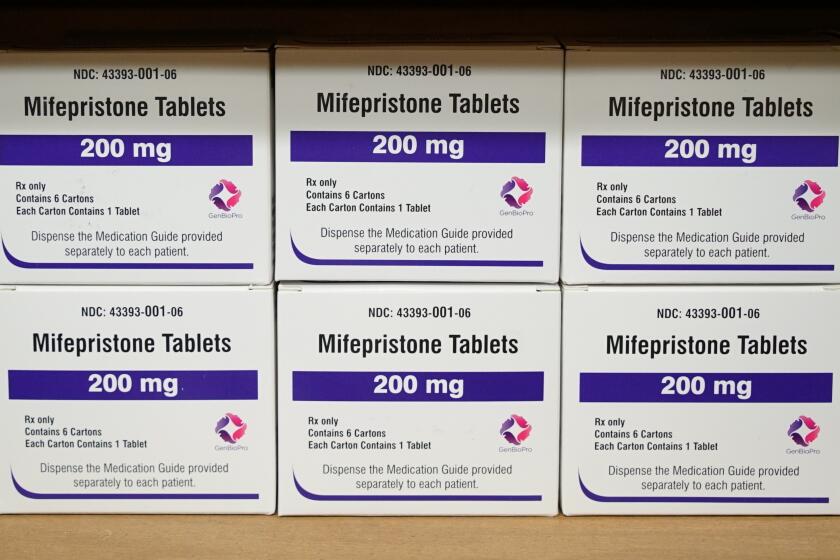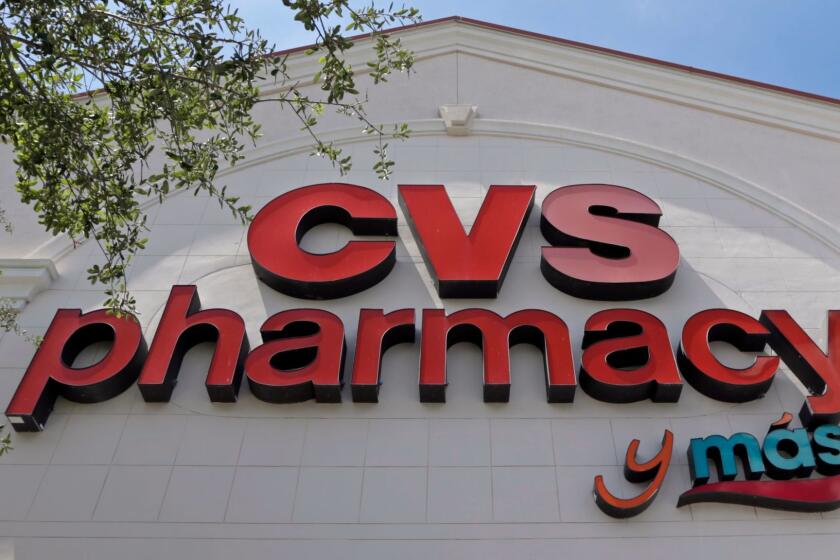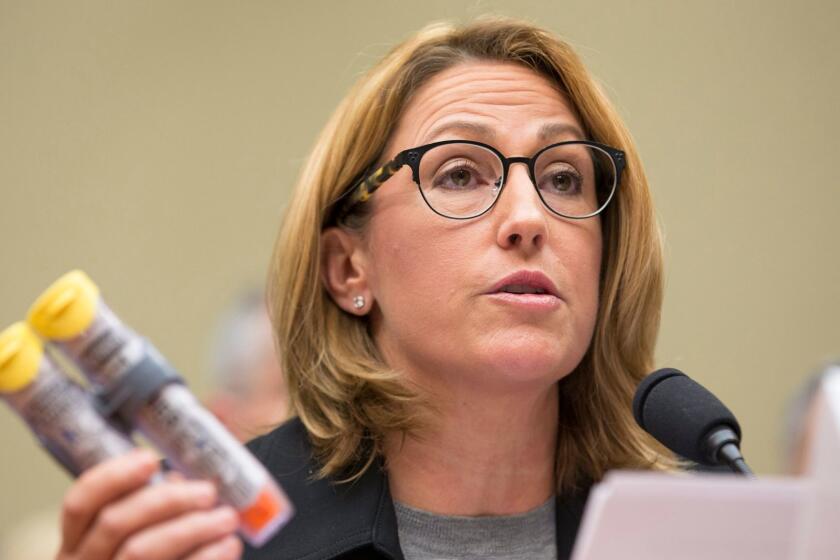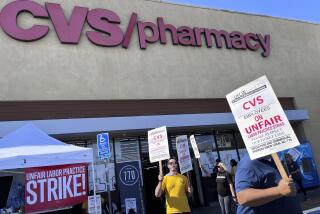Column: How Walgreens, CVS and Rite Aid tried to take over healthcare â and failed

There was a time, in the misty, rose-hued past, when the three big drugstore chains looked poised to take over the American healthcare system.
Drug retailer CVS and health insurer Aetna announced a $69-billion merger. Walgreens made a $5.2-billion investment in primary care provider VillageMD and took a $330-million stake in home care provider CareCentrix, giving it control of both firms. Rite Aid wasnât as aggressive, but still built up its national footprint to 5,000 stores before cutting back to about 2,100.
The companies talked about evolving into one-stop medical providers so that âpatients discharged from the hospital ⌠will be able to stop at a health hub location to access services such as medication evaluations, home monitoring and use of durable medical equipment, as neededâ (according to the merger announcement by CVS and Aetna).
Weâre rightsizing the footprint and getting our expenses in the right place. We donât see the growth coming fast enough in certain markets.
— Walgreens executive John Driscoll admits the companyâs healthcare ventures have been disappointing
The American Hospital Assn. issued an alarming report listing CVS and Walgreens among companies that had grabbed market share in âprimary care, concierge medicine, virtual care, in-home medical services and elsewhere.â
It seemed that this trend might continue, as the pharmacy chains exploited their networks of stores on virtually every American corner.
Get the latest from Michael Hiltzik
Commentary on economics and more from a Pulitzer Prize winner.
You may occasionally receive promotional content from the Los Angeles Times.
That wasnât so long ago. The CVS-Aetna merger was in 2017. Walgreens took over VillageMD in 2021 and CareCentrix just last year.
Now, however, their dream of playing a central role in a restructured nationwide healthcare system seems to be fading.
The pharmacy chains have discovered that taking a larger role in the healthcare system than simply dispensing prescriptions and selling over-the-counter products is more complicated and costlier than they expected.
âIt has taken us longer than anticipated to realize the cost synergies across the combined assets,â John P. Driscoll, the head of Walgreensâ U.S. Healthcare division, told investment analysts at the companyâs fourth-quarter earnings conference call on Oct. 12.
He said VillageMD would be focusing on âour highest opportunity marketsâ â evidently affluent urban areas â by shutting down in five markets and closing 60 VillageMD clinics over the coming year.
By capitulating to antiabortion forces and showing its cowardice, Walgreens abandons its own customers and its corporate principles.
âWeâre rightsizing the footprint and getting our expenses in the right place,â he said. âWe donât see the growth coming fast enough in certain markets.â
At CVS, executives paint the effort to remake the company into an integrated healthcare provider as very much a work in progress.
âIf you think about whatâs happening in America relative to healthcare,â Chief Executive Karen Sue Lynch told investment analysts at a Morgan Stanley healthcare conference in September, âitâs ... very hard for people to access care.â
She said the companyâs goal is âto make sure that people have seamless connected experiences across the spectrum of healthcare. And I would argue that the businesses that weâre creating will enhance the value of consumer experience.â
The tendency of the American healthcare system to confound promises and expectations was underscored in 2021. Thatâs when billionaires Warren Buffett, Jeff Bezos and Jamie Dimon had to admit that their plan to solve the systemâs problems, as if by sheer star power â well, to be fair, through âtechnology solutionsâ â had been obliterated.
The trio had announced their venture in 2018 to a blast of worldwide fanfare. If they couldnât succeed, it was said, no one could. The idea was that there was some magic bullet for reducing healthcare costs that had evaded everyone for years, but that they could discover.
Less than three years later, they had been subjected to a ritual mortification. Their joint venture, christened Haven, shut down. For all their efforts, primary care had not become easier for millions of Americans to access, insurance benefits were as opaque and arcane as ever, and prescription drug pricing was still a public scandal.
The drug chainsâ expansion strategies have exposed them to complexities in American healthcare â political controversies, Medicare regulations, issues of prescription drug pricing â that they had not faced in their core businesses, leading to a string of unpleasant surprises.
The CEOs of drug retailer CVS and health insurer Aetna were marvelously in sync Sunday when they jointly announced their companiesâ $69-billion merger deal.
Walgreens became embroiled in abortion politics in March, when it said it would not distribute or ship a drug used for medication abortions in at least 21 red states, including at least four where abortions were still legal.
The company made the announcement after a group of red state attorneys general threatened it with unspecified âconsequencesâ for shipping the drug, mifepristone, the long-assumed legality of which had been challenged in federal court.
Walgreensâ national footprint made it vulnerable to the threat â and to a backlash from blue states such as California, where Gov. Gavin Newsom said he would stop the state from doing business with the company, or any other âthat cowers to the extremists and puts womenâs lives at risk.â
CVS ran into the buzz saw of Medicare politics in August, when a New York state judge blocked the transfer of 250,000 Medicare patients to Aetnaâs Medicare Advantage plan. The transfer was part of a contract worth $15 billion to Aetna over five years. Medicare Advantage plans provide more benefits to enrollees than traditional Medicare but have come under fire for costing the government too much for too scanty patient gains.
The company also disclosed a potential hit of $800 million to $1 billion in its 2024 operating income from a downgrade by government authorities in its Medicare quality rankings, known as âstar ratings.â
The move of CVS into the pharmacy benefit manager business through its $24-billion acquisition of the Caremark PBM in 2007 also may not have worked out as it expected.
Diabetes doctor Irl B.
PBMs originated as intermediaries to help health insurance plans process prescription claims, steer doctors and hospitals to the cheapest drug alternatives, and allow insurers to combine their customer bases for greater leverage in negotiations with drug manufacturers. Eventually they got blamed for driving up drug costs by extracting their own profits without producing sufficient discounts for their clients.
In August, Blue Shield of California rattled Caremark by cutting most of its ties with the PBM and turning over most of its responsibilities to four competitors, in a strategy aimed at cutting its prescription costs, which come to more than $600 billion annually, by as much as $500 million a year.
That was the second blow to Caremark in a year; in November managed care insurer Centene said it was turning pharmacy benefits for its 20 million enrollees over to Express Scripts starting next year, on a $35-billion contract.
The Blue Shield announcement drove the CVS stock price down by about 9%, a reaction that CEO Lynch called âoverblownâ at the Morgan Stanley conference. She also cast doubt on Blue Shieldâs assertion that the PBM change would save it $500 million. âWeâre not earning that kind of money on that account,â she said.
As for Rite Aid, that chain has problems all its own. The firm filed for bankruptcy protection on Oct. 16, citing a crushing debt load and excessive rent for underperforming stores. The company subsequently announced plans to close 154 stores, including 31 in California.
Rite Aid is also facing a federal lawsuit accusing it of filling unlawful prescriptions, mostly for opioids. It isnât alone in being accused of complicity in the opioid crisis: In a 2022 legal settlement with state attorneys general, CVS agreed to pay as much as $4.9 billion over 10 years, Walgreens up to $5.52 billion over 15 years, and Walmart, which has become a major competitor in the pharmacy business, up to $2.74 billion within six years.
At this moment, itâs clear that pharmacy services remain overwhelmingly the drivers of revenue and profit for the drugstore chains. At CVS last year, pharmacy services and other retail sales provided $14 billion in operating profit on $275.8 billion in revenue, versus $6 billion in operating profit on $91.4 billion in revenue from healthcare benefits.
At Walgreens, retail pharmacy sales provided $3.7 billion in operating profit on $110.3 billion in revenue in the fiscal year that ended Aug. 31, while U.S. healthcare generated a loss of $556 million on $6.6 billion in revenue.
One other factor stands between the drugstore chains and their ambitions to cast a wider net over American healthcare: The presence of well-heeled rivals with ideas of their own. Walmart, the nationâs largest retailer, offers customers low-priced prescriptions and telehealth services, and has been opening walk-in clinics around the country.
Then thereâs Amazon, which may have felt burned by the failure of Haven, but acquired concierge care provider One Medical in February for $3.9 billion and offers its Amazon Prime members access to scores of generic medicines for a monthly fee.
The drugstore chains arenât signaling that theyâre giving up on their long-term goals â but warn investors that they may incur losses for years before the long term becomes the here and now.
They and their rivals in retailing and clinical services may well change the course of American healthcare in the future, but it should not be forgotten that theyâre all fundamentally in it for the money. Their promises of cheaper, more efficient and more effective healthcare for the average American should be treated with the all-purpose medicine of a healthy dose of skepticism.
More to Read
Get the latest from Michael Hiltzik
Commentary on economics and more from a Pulitzer Prize winner.
You may occasionally receive promotional content from the Los Angeles Times.














